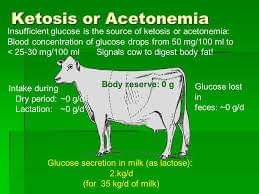KETOSIS (ACETONAEMIA) IN DAIRY CATTLE
Dr Ajeet Singh, Livestock consultant, Gorakhpur
Ketosis in ruminants is a disease caused by impaired metabolism of carbohydrate and volatile fatty acids. Biochemically it is characterised by ketonemia, ketonuria, hypoglycemia and low levels of hepatic glycogen.
Cause—
Ketosis is a metabolic disorder that occurs in cattle when energy demands (e.g. high milk production) exceed energy intake and result in a negative energy balance. Ketotic cows often have low blood glucose (blood sugar) concentrations.
When large amounts of body fat are utilised as an energy source to support production, fat is sometimes mobilised faster than the liver can properly metabolise it. If this situation occurs, ketone production exceeds ketone utilisation by the cow, and ketosis results.
In the beef cow, this is most likely to occur in late pregnancy when the cow’s appetite is at its lowest and the energy requirement of the growing calf near its peak.
In the dairy cow, the mismatch between input and output usually occurs in the first few weeks of lactation, because the cow is not able to eat enough to match the energy lost in the milk.
Symptoms–——–
Reduced milk yield
Weight loss
Reduced appetite
Dull coat
Acetone (pear drop) smell of breath/ or milk
Fever
Some develop nervous signs including excess salivation, licking, agression etc.
For every cow with clinical signs there are probably a number of others with sub-clinical signs.
Treatment-———
- Intravenous injection of 500 ml of a 50% solution of dextrose.
- Propylene glycol or glycerin (225 gm twice daily for 2 days followed by
110 g daily for 2 days) can be administered as a drench in the field. - Ammonium lactate 300g, daily for 5 days in repeated doses to be
effective.
Hormonal therapy———-
- Dexamethasone-25 mg
- Anabolic steroids 30 mg followed by oral propylene glycol (100m1; twice
daily).
Miscellaneous treatment - Chloral hydrate: initial does of 30 g orally followed by 7 g twice daily for
several days. - Vitamin B12 and cobalt 750 mg 3 doses at 1-3 days intervals.
- Addition of nicotinic acid in the feed(12 g daily).
The initial aim of treatment is to restore the lack of glucose in the body.
A quick-acting glucose supplement is required immediately. Follow-up treatment is aimed at providing a long term supply of glucose.
Glucose replacement
Intravenous administration of a dextrose solution by a veterinarian is effective in the short term, but follow-up treatment is essential if relapses are to be avoided.
Drenching with propylene glycol or glycerine has longer term effects. It also has the benefit of ease of administration. Treatment should be continued for two to four days. Several commercial compounds contain propylene glycol and glycerine.
Hormonal therapy-———-
Many of the long-acting corticosteroids have beneficial effects in ketosis. They are administered by the veterinarian as a single injection.
Corticosteroids have the ability to break down protein in muscles to produce glucose, which immediately replenishes the depressed blood glucose levels.
When using corticosteroids, it is important to supply an adequate amount of glucose either as a high carbohydrate diet and/or propylene glycol drenches to prevent excessive breakdown of muscle protein.
Prevention:———
It is important to prevent ketosis from occurring, rather than treating cases as they appear.
Prevention depends on adequate feeding and management practices.
In times of feed deficiency because of drought or other reasons, the provision of supplementary feed with adequate amounts of carbohydrate is essential. The best feeds tend to be good quality hay, silage, or cereal grain.
The body condition of the dairy cow is important at calving. Cows should be on a rising plane of nutrition up to calving with the aim to calve in good condition.
After calving, the cow has the potential to reach maximum efficiency in milk production, but feed requirements for high production are often greater than the voluntary intake of pasture can provide.
Therefore an energy supplement is required and there is evidence that this will improve production and reproductive performance, and decrease the risk of ketosis. The best supplements are good quality hay, silage, or cereal grains. Supplements should be fed at least until the peak of lactation is reached or longer depending on the quality and quantity of available pasture.
Occasionally, very high-producing cows will be susceptible to ketosis every year. In these cases a preventive drenching program of propylene glycol immediately after calving may avert ketosis in individual problem cows.
Control-———–
- Adequate caloric intake should be ensured.
- Use silage or hay as maintenance ration supplemented with 1Kg/day
concentrate and gradually increased to 5 Kg daily at calving time. - After calving, the concentrate ration should be increased gradually
(3Kg/100Kg body weight for maintenance and 1Kg/3Kg milk). - Provide good quality and ground maize.
- Adequate exercise
- Ration must contain adequate cobalt, phosphorus and iodine
- 110g of sodium phosphate daily for 6 weeks commencing at calving or
propylene glycol (350 ml daily).
Reference-On request.


